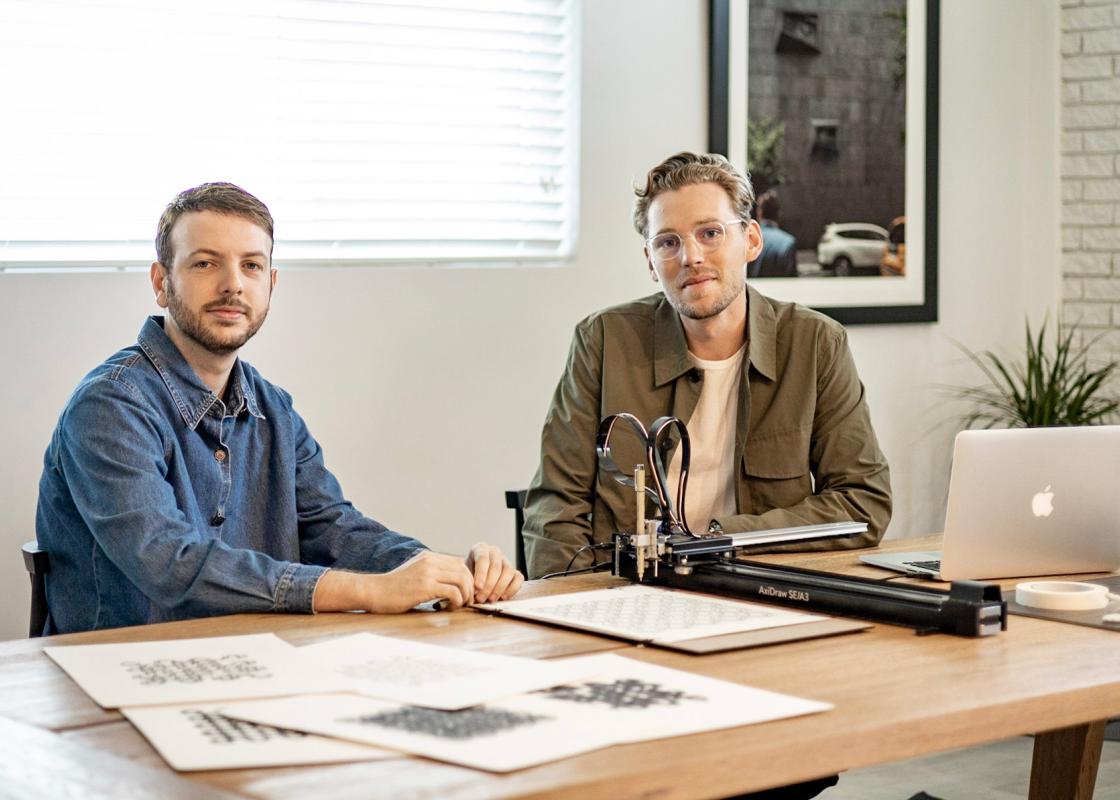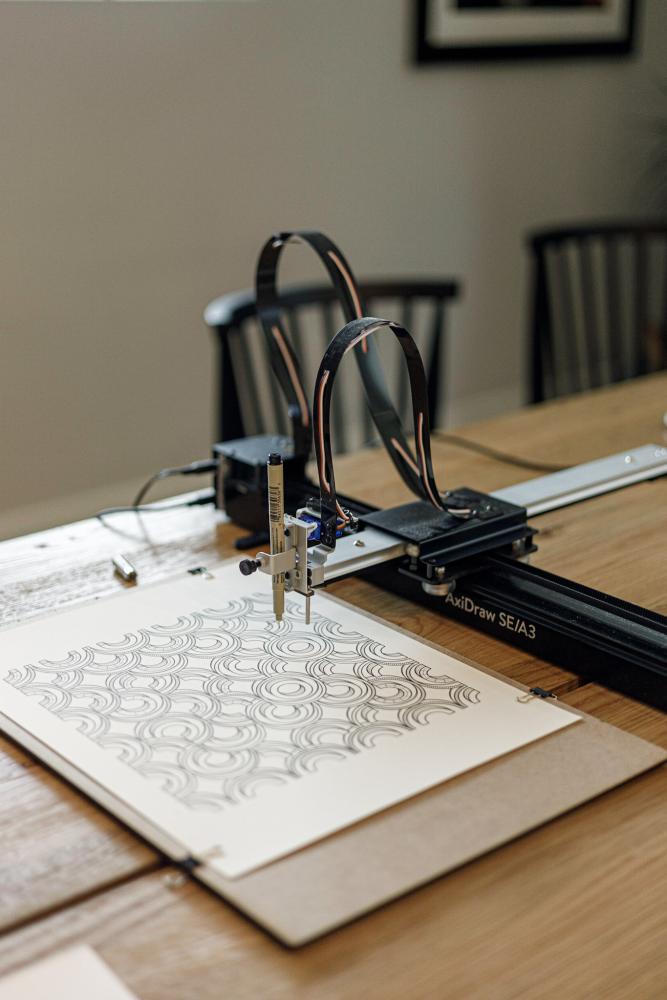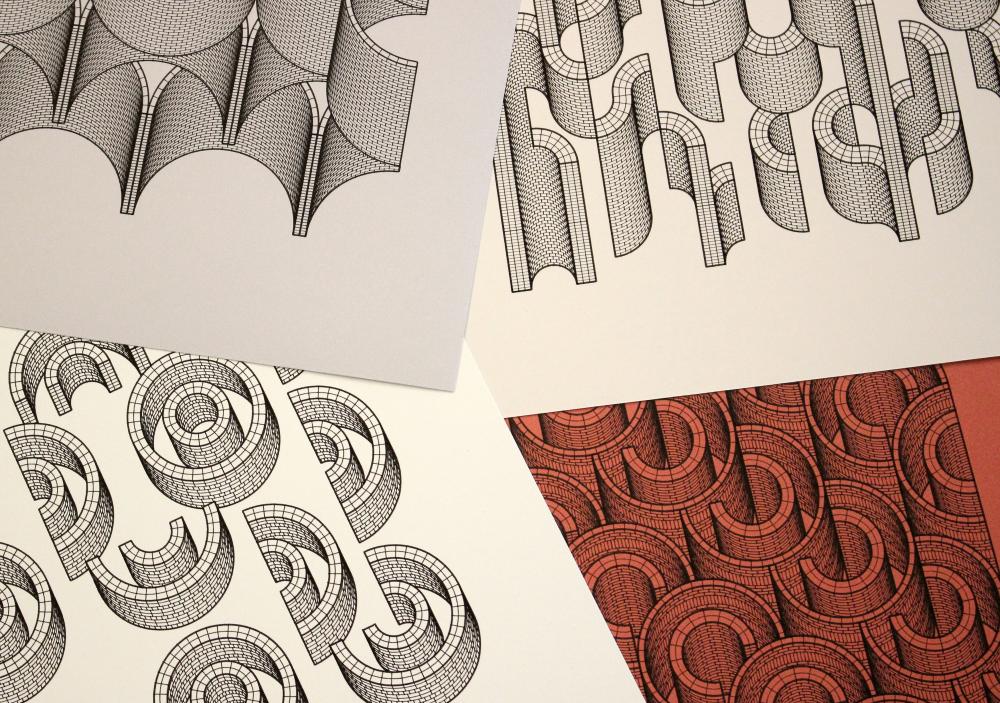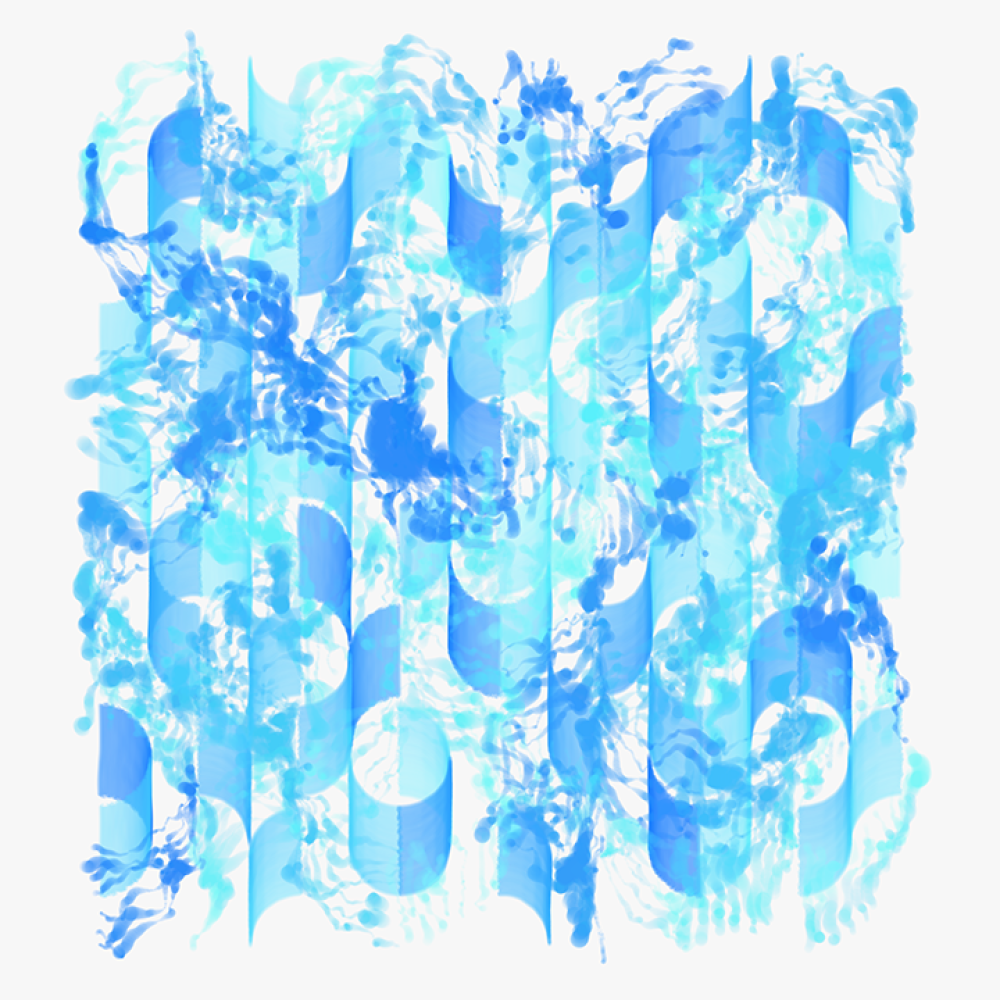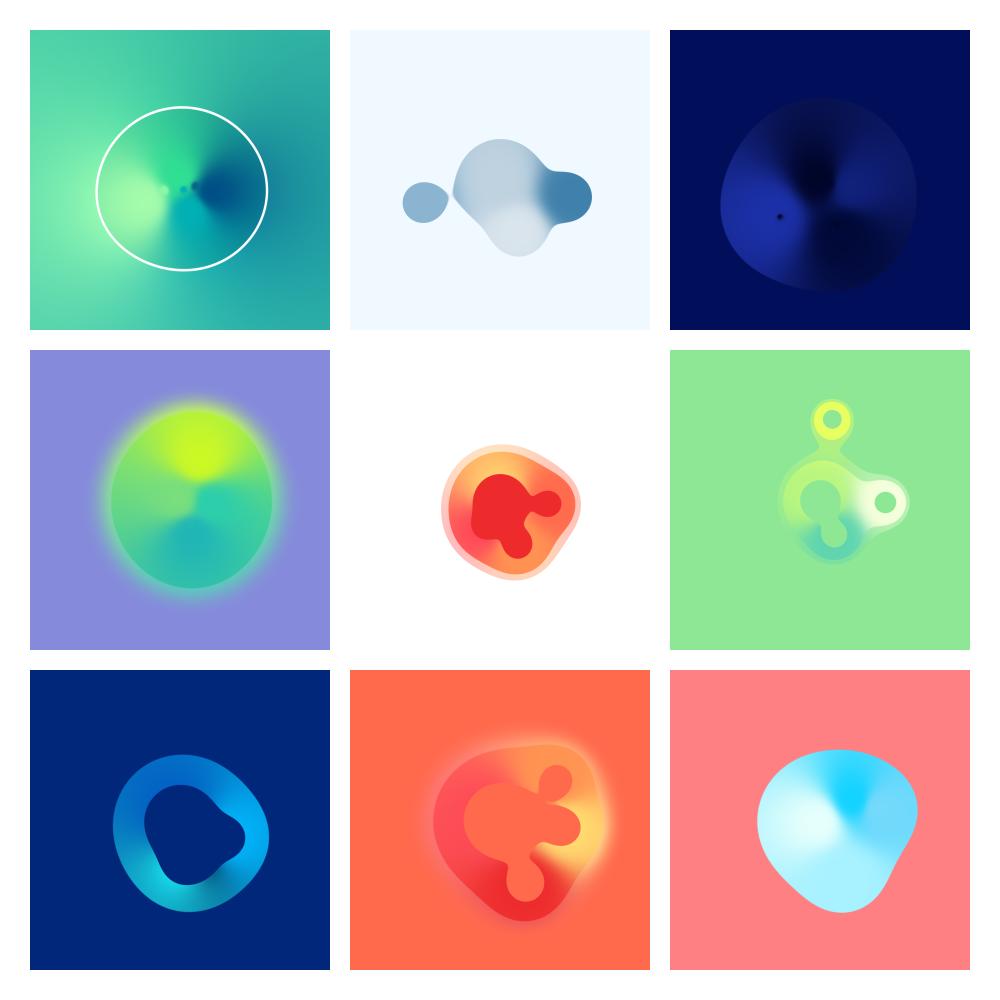Tell us about your work! What is WAWAA?
Alex Warr & Zach Walters (AW & ZW): WAWAA is a collaboration between the two of us—Alex Warr and Zach Walters—focused on art, architecture, and design. Our work ranges from buildings to generative art; we seek to leverage our individual and collective strength in all things design.
How (and why) did you start WAWAA? For those who might be unfamiliar, could you share a bit about generative art and NFTs?
AW & ZW: WAWAA gradually emerged over the past eight years since we began collaborating on projects while both studying architecture at the University of Texas at Austin. In the beginning, we were primarily interested in architectural projects, but we have since expanded the scope of our work into other areas, including generative art.
In generative art, artists create systems or algorithms that produce art with a degree of built-in unpredictability or randomness. Our work in generative art has been primarily focused on on-chain generative art. We create a generative algorithm that is written as code and stored on the Ethereum blockchain, which allows collectors to purchase unique outputs generated by the algorithm. When a piece is purchased, a pseudo-random hash is created, which is used as an input for the script and determines the specific characteristics of the piece. One of the interesting aspects of this medium is that neither the artist nor collector knows exactly what each piece will be like before it is purchased and generated by the algorithm.
You are both trained as architects. Could you share about your pathway in architecture that led to this project? Are you still active as architectural designers?
AW & ZW: We both graduated with Bachelor of Architecture from the UT Austin School of Architecture and went on to work at architecture firms.
Alex has pursued interests in architecture and 3D visualization. He has led visualization efforts in an architecture firm, eventually breaking out to do freelance visualization and design work. He continues to work in architecture and is currently collaborating with Houston-based Rivers Barden Architects on a large recreation/hospitality project in South Carolina.
During school, Zach became interested in parametric design and computation as tools for the design process. This has led to a further interest in creative coding and generative art, which he has explored in parallel to working in the field of architecture. Zach recently received his architecture license and is currently doing freelance architectural design work in addition to working on WAWAA projects.
Can you tell us about a transformative project that you’ve completed?
AW & ZW: Timepiece, our first on-chain generative art project, was very transformative. The project, which is a series of 500 generative clocks that run in real-time within a web browser, was an exploration of objective and subjective time. We were interested in approaching the clock in an abstract and playful way that embraces the ambiguity of time and leverages the medium of on-chain generative art, creating pieces that are dynamic and in continuous transformation. Each of the 500 iterations of Timepiece has unique graphic and kinetic qualities that give it a distinct character—from calm and subtle to fast and playful.
This project was the culmination of an idea that began in 2018 as an entry piece for a design competition hosted by Samsung and Dezeen. Prior to making Timepiece, we had explored a lot of the same topics and techniques—visualization, image-making, computation, and coding—primarily as tools in the design process and viewed them more as a means to an end. However, the process of developing Timepiece as a standalone work of generative art—removed from the realm of architecture and design in which we had been working—helped expand our ideas about the type of work we could create and how we might leverage the tools and skills that we have developed in the field of architecture in new ways.
Since Timepiece, we have completed two additional long-form generative art projects, Freehand and Brickwork.
What are you working on currently?
AW & ZW: We recently completed our third generative art project, Brickwork. The project is a series of drawings of fictional masonry constructions, both possible and impossible, created by an algorithm such that each output can be directly plotted with a pen plotter. This translation from a digital to a physical medium has produced some interesting discrepancies, caused by the types of paper and pens used and other factors. We are excited to continue exploring this connection between algorithmically generated digital work and physical media with pen plotters and other tools.
We have also started to explore a new project in furniture design, and we are planning to take on architecture projects as well.
What inspires you today?
AW & ZW: Like many generative artists, we are heavily inspired by Sol LeWitt’s wall drawings. There is a strong parallel between LeWitt’s written instructions for executing the wall drawings and the algorithms behind generative art, both in their procedural nature and in how the artist can give up a degree of control by creating indeterminate instructions. We thought a lot about LeWitt’s works and the idea of embracing this unpredictability when creating Freehand—a series of “freehand” mixed-media drawings that are made by an algorithm.
Who was/were important mentor(s) for you earlier in your careers?
AW & ZW: Murray Legge has been an important mentor. Alex had him as a professor for the comprehensive studio at architecture school and then worked in his office. We have both continued to have a relationship with Murray over the last few years. He does inspiring work and has provided a lot of guidance for us throughout our journey in the profession. Murray’s work is also not limited to architecture. He is one third of Legge Lewis Legge, an interdisciplinary collaborative focusing on art and architecture that works in the realm of public art, architecture, and installations. We continue to be inspired by his work and are lucky to call him a mentor.
What are your favorite parts of your work? What do you find the most challenging?
AW & ZW: Right now, our favorite part of the work is how we have gotten back into making things. Although we love architecture, we have really enjoyed the freedom that generative art has afforded us as well as its ability to get faster and more tangible results, especially using tools such as the pen plotter.
Sharing our work with a wider audience is one of the things we are finding to be most challenging. The digital nature of the work brings up interesting questions about where and how to showcase the work, in contexts other than online and social media. Recently, we were able to take part in a small exhibition here in Houston where we displayed a Timepiece on the side of a building using a projector. That was really exciting for us, and we would love to find more ways to show our work, in both traditional and nontraditional ways.
What impact does being in Houston have on WAWAA’s sensibility?
AW & ZW: Houston’s rich art and architecture culture (one that is probably a little underrated by people who don’t live in the city) has really been a catalyst for us in terms of interacting with great work and being inspired. The Houston art scene has it all, from world-class art and architecture, to locally and regionally oriented galleries and shows.
The tight community of designers and artists is what led us to discovering Art Blocks, the platform that hosted Timepiece. Art Blocks, which was founded in Houston, was a big encouragement for us to push Timepiece forward into a finished product because it is the perfect home for this type of work. We are excited to see how Art Blocks continues to push the connection between the traditional art and generative art worlds.
What is one of your favorite places in Houston?
AW & ZW: The Cy Twombly Gallery at the Menil Collection comes to mind. It is a wonderful marriage of art and architecture. It is the perfect place to spend a few minutes or a couple hours.
Zach Walters is an architect and artist based in Houston. His work explores the relationship between physical environments and digital tools—creating generative art algorithms and realizing the outputs of these algorithms in physical media, including drawings, objects, and spaces.
Alex Warr is a designer living in Houston. He is a graduate of the University of Texas at Austin School of Architecture, and his current work explores digital art, visualization, and architecture.
This interview is a part of the New Design Talent series created by Jack Murphy, former Editor of Cite. It is intended to highlight emerging designers who are newer to the Houston area design community.


